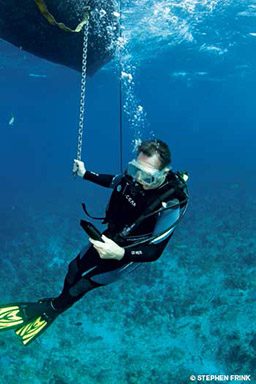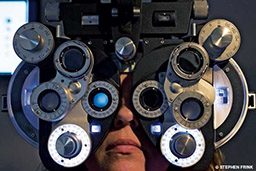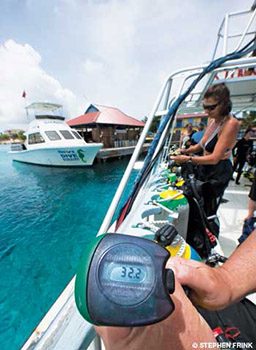Oxygen toxicity has been known since the 19th century, but we are still learning about its causes and mechanisms. In diving practices of years past, pure oxygen and gas mixtures with oxygen content different than that of air were used exclusively by military and commercial divers. In the last several decades enriched air nitrox (EAN) became a part of mainstream recreational diving, while technical diving, which maximizes the use of oxygen to minimize decompression risks, is becoming increasingly popular. The accumulated experience in recreational and technical diving now exceeds the previous experience of military and commercial diving. Both scientific research and diving practices advanced our knowledge of oxygen toxicity, and from time to time we should take a step back to make sure we are all sharing the benefits of this knowledge.
Oxygen convulsions were first described by Paul Bert in 1878. He noted convulsions in larks in air compressed to a pressure of 20 atmospheres absolute (ATA). When he compressed larks in pure oxygen, they convulsed at pressures as low as 5 ATA. Bert concluded that convulsions represent a sign of oxygen toxicity upon the central nervous system (CNS), which was shown to be correct in later research.
In 1899 Lorrain Smith described pulmonary oxygen toxicity in rats. Problems started when rats breathed 45 percent oxygen at normal pressure. When breathing 73 percent oxygen, rats developed fatal pneumonia in four days. At higher oxygen pressure, these symptoms developed sooner.
Since that time we have learned more about the manifestations and some of the underlying mechanisms of oxygen toxicity. All manifestations of oxygen toxicity are dose dependent. Symptoms of CNS oxygen toxicity, which include seizures, may occur after short exposures to partial pressures of oxygen greater than 1.3 ATA in exercising divers, which equates to breathing pure oxygen at 10 feet of seawater. Resting divers in comfortable conditions tolerate 1.6 ATA of oxygen well. Pulmonary manifestations occur after days of exposure to partial pressures of inspired oxygen greater than 0.45 ATA. In addition, repetitive and prolonged use of hyperoxic gases (at least 30 hours in 10 days of an oxygen partial pressure greater than 1.3 ATA) in modern diving has revealed ocular manifestations (hyperoxia-induced myopia). Cold, exercise, some drugs and increased partial pressure of carbon dioxide increase susceptibility to oxygen toxicity.
Who is Exposed to the Risk of Oxygen Toxicity?
Divers using EAN as well as both open-circuit and rebreather divers who use mixed gases are exposed to the risk of oxygen toxicity. CNS oxygen toxicity may occur in divers using EAN if they exceed depth limits for a given oxygen content or if they mistakenly breathe gas that contains more oxygen than they thought it did. Cold, strenuous exercise, some medications and other known and unknown individual and environmental factors may increase the risk of oxygen toxicity — even within limits for a given EAN mix.

Divers using mixed gases in open-circuit scuba diving incur the risk of confusing the various gas mixes they carry and of using too much oxygen during decompression. Closed-circuit-rebreather divers run the risk of incorrectly selecting the partial pressure of oxygen as well as mechanical errors. These may include errors in gas mixing, displaying erroneous oxygen values and excess carbon dioxide in the breathing loop due to equipment malfunction.
CNS oxygen toxicity is the main form seen in diving. Pulmonary oxygen toxicity is not of concern except in very long technical dives (extended cave or rebreather dives, for example) lasting six to 12 hours or more. Prolonged dives within the safe limits for CNS oxygen toxicity may still cause ocular toxicity, which manifests as a narrowing of the visual field and myopia.
Divers suffering decompression illness may also be at risk of oxygen toxicity during the treatment they receive. Pure oxygen at sea-level pressure (normobaric oxygen), often provided as first aid during evacuation, is well tolerated for up to 24 hours. However, because divers will most likely be treated with hyperbaric oxygen as well, air breaks should be considered in extreme circumstances when access to hyperbaric treatment is delayed. Generally, such air breaks will occur as a matter of course as the injured diver eats, drinks and goes to the bathroom. Note that these air breaks are intended to forestall symptoms of pulmonary oxygen toxicity; there is no risk of seizure or other CNS manifestations in these circumstances. Air breaks should not be used when transport times are shorter than a few hours.
During hyperbaric chamber treatment divers may be exposed to much higher oxygen pressures than would be safe to use while diving. The oxygen pressure used during treatment represents a balance between the benefit expected and the potential risk. In general, oxygen is better tolerated in dry, resting conditions than in wet conditions and while exercising as in diving. In addition, there is no risk of drowning in a dry hyperbaric chamber, which is the major concern with oxygen toxicity in diving.
Oxydative and Nitrosative Stress

At the root of oxygen toxicity are reactive oxygen species (ROS), short-lasting forms of oxygen molecules that occur as byproducts of normal metabolic processes and play an important role in the body’s normal functioning. With increased oxygen pressure, the amount of ROS increases, and it may oxidize other molecules important for biological processes and the integrity of biological structures. Especially important is the interaction of ROS with nitric oxide (NO), another important signaling molecule in physiological processes.
ROS occurs everywhere in the body, particularly in areas of high blood circulation and oxidative metabolism. NO is present in every tissue of the body, but it may play different roles depending on the specific tissue. The interaction of ROS and NO exhibits the most dramatic effect in the central nervous system and lungs, although practically every organ and tissue may be affected. Recent studies have revealed that chronic pulmonary oxygen toxicity at low oxygen pressure is caused mainly by ROS, while newly described acute pulmonary oxygen toxicity is caused mainly by NO-mediated massive sympathetic outflow from the brain.
Effects of Oxygen on the Autonomic Nervous System
NO has an important role in oxygen toxicity through modulation of the autonomic nervous system. The autonomic nervous system consists of two opposing sides: the sympathetic and parasympathetic, which regulate function of every organ. In general, the sympathetic nervous system excites the body, preparing it for action, while the parasympathetic nervous system calms it down to promote recovery and restoration.
In the central nervous system, NO decreases the activity of the sympathetic nervous system, while in the periphery it causes widening of blood vessels (vasodilation). When the concentration of oxygen is increased at normal or slightly elevated ambient pressure, ROS in the periphery bind with NO, and thus arteries remain narrow, causing hypertension. At this point, baroceptors, specialized neuronal nodes involved in blood-pressure regulation, become more active and send the brain an increased flow of signals, which decrease the brain’s sympathetic activity and help reduce blood pressure. This reduction of blood pressure was noticed as a secondary benefit in hypertensive patients undergoing hyperbaric oxygen therapy for other reasons.
However, if oxygen pressure exceeds 3 ATA, all NO is occupied with ROS, and none remains to control the sympathetic nervous system. Sympathetic activity becomes suddenly extreme, and levels of adrenaline and noradrenaline in circulation increase dramatically (the so-called “adrenergic storm”). This potentiates the narrowing of arteries in the periphery and increases blood pressure and heart rate. The arteries of the heart may also narrow to the point that the heart muscle does not receive enough blood. The pumping efficacy of the left heart fails, the blood pressure in the pulmonary circulation increases, pulmonary capillaries are damaged, and gas exchange becomes compromised.
This acute lung damage precedes the onset of seizures. Artificial stimulation of the parasympathetic system (via the vagus nerve) may counteract these effects. Indeed, a new treatment method has been developed for patients with epilepsy that could not be controlled with medication. These patients receive an implant that provides continuous electric stimulation of the vagus nerve and prevents the occurrence of seizures. Similar effects were demonstrated using the drug propranolol, an adrenergic blocker, which reduces the sympathetic activity. Unfortunately, propranolol is not a very selective beta blocker and may have serious side effects. Protective effects in humans have not been confirmed; do not use it unless directed to do so by a physician.
The Autonomic Nervous System as a Key to Understanding Oxygen Toxicity
The role of the autonomic nervous system in oxygen toxicity in humans has not yet been sufficiently explored. The autonomic nervous system changes with age and various chronic diseases that affect many divers. However, we have just scratched the surface of the problem and have few answers. DAN® was instrumental in studying two common drugs that may affect the autonomic nervous system and thus the risk of oxygen toxicity: PDE-5 inhibitors (used to treat erectile dysfunction) and pseudoephedrine.

DAN was contacted by a diver who experienced symptoms of oxygen toxicity after using EAN at an oxygen partial pressure of 1.3 ATA. He had done similar dives many times before without any problems. His exposure to oxygen was within limits usually considered safe, but this time he had used Cialis (a PDE-5 inhibitor) the night before his dive. These drugs cause widening of the arteries responsible for erection, but theoretically they may cross from the circulation into the brain and may increase sympathetic activity. However, it was not known whether this could affect a diver’s risk of oxygen toxicity. Dr. Ivan Demchenko and his team at Duke University conducted an animal study and demonstrated that rats treated with PDE-5 seized sooner than untreated animals. The lesson for divers is that use of PDE-5 inhibitors the night before diving may not be safe. Attention should be given to the effective duration of the chosen medication and the partial pressures of oxygen likely to be encountered on planned dives. The diver should discuss dive plans with a DAN medic or a doctor trained in dive medicine.
In the case of pseudoephedrine, things evolved differently. Several divers who experienced symptoms of oxygen toxicity called DAN and blamed the drug pseudoephedrine, an active ingredient in many over-the-counter medications (such as Sudafed®) used to treat congestion. DAN contracted an animal study with the University of South Florida. The study indicated that normal doses of pseudoephedrine should not increase the risk of seizures in the majority of divers, but there was a huge individual variability in susceptibility to oxygen toxicity — sufficient variability to explain why divers sometimes get toxicity symptoms despite “safe” exposures. It was also demonstrated that very large doses, which may be achieved if a diver uses multiple over-the-counter drugs containing pseudoephedrine, may increase susceptibility to oxygen toxicity.
Protection from Oxygen Toxicity
So far there are no drugs that would practically increase tolerance to oxygen, but these may be developed in the future. There were hopes that some antioxidants such as vitamin E and vitamin C could protect against oxygen toxicity. While this may be true in animals with a lack of these vitamins, in normally fed animals no beneficial effect of vitamin supplementation has been demonstrated. On the other hand, there are many drugs that may increase susceptibility to oxygen toxicity such as reserpine, quanethidine, thyroxin, disulfiram and others. Divers taking medications for chronic conditions should consult their physicians before getting involved with nitrox or mixed-gas diving.
The best protection is to keep inspired oxygen pressure at or below 1.2 ATA while physically active and at or below 1.6 ATA during decompression. In addition, use low-oxygen breaks, control carbon dioxide, do not overexert yourself, stay warm, and be fit and healthy. Divers wishing to further reduce the risk of drowning due to seizure might consider using a full face mask and should never dive alone.
About the Author
Petar Denoble, M.D., D.Sc., is the senior director of DAN Research. After graduating from medical school, he joined the navy in the former Yugoslavia and specialized in naval and diving medicine. For 13 years he was involved with training, supervision and treatment of divers in open-circuit, closed-circuit, deep-bounce and saturation diving. His doctoral thesis focused on studying oxygen consumption in underwater swimming. Denoble has been at DAN for 20 years and has been involved in the development of the largest database of exposure and outcomes in recreational diving, the monitoring of diving injuries and the study, treatment and prevention of fatal outcomes and long-term consequences of diving accidents.
© Alert Diver — Q1 Winter 2013